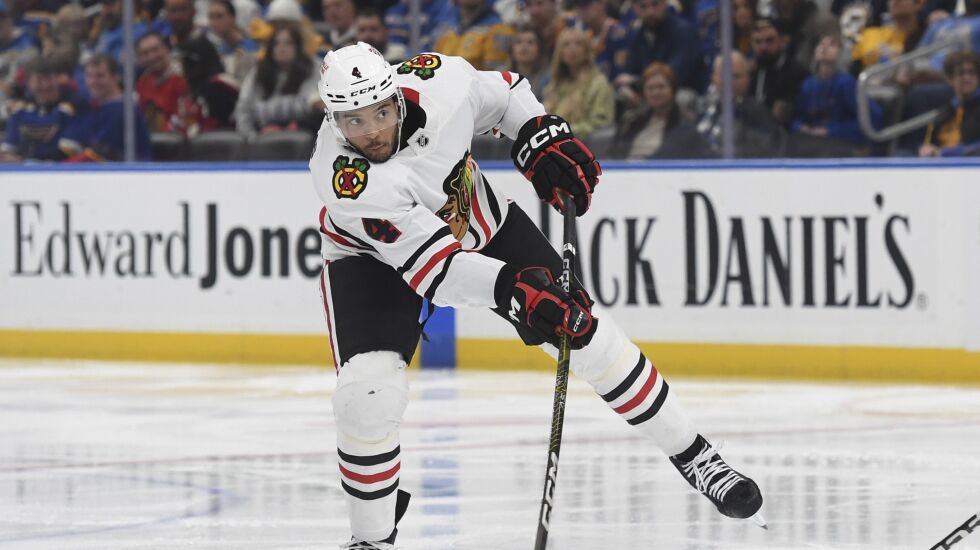
EDMONTON, Alberta — It’s funny how the timing of Blackhawks defenseman Seth Jones getting the splint removed from his previously injured right thumb aligned with a sudden spike in his production.
‘‘I’m not going to make an excuse for anything,’’ Jones said with a sly grin Friday. ‘‘But it’s kind of weird how that set up.’’
The splint finally came off about three weeks ago. Jones said his thumb doesn’t feel 100% yet, but it’s ‘‘good enough.’’ And from Jan. 3 through Thursday, he broke for 12 points — three goals, nine assists — in 11 games, more than doubling his season total.
The points came in different ways. Jones made some smart breakout passes, jump-starting chain reactions that have led to goals by Jason Dickinson on Jan. 21 and Sam Lafferty on Jan. 24.
He drove to the net, positioning himself to score the Hawks’ first power-play goal by a defenseman in two seasons Jan. 3 and to score the overtime winner Jan. 17. Jones’ backdoor presence also forced Kraken defenseman Jamie Oleksiak to stand in the crease Jan. 14, allowing Jonathan Toews to score by deflecting the puck in off him.
Most notably, he got shots cleanly through traffic, scoring the tying goal Jan. 17 by doing so and setting up Lukas Reichel, Philipp Kurashev and Toews for tip-in goals on Jan. 8, Jan. 17 and Jan. 19, respectively.
‘‘Obviously, I’m playing better overall,’’ Jones said. ‘‘I’m just trying to move my feet, take opportunities when they’re there and get the puck in some guys’ hands.’’
The continued steadiness of his pairing with Jake McCabe also has freed him to take more chances offensively, some of which inevitably pay off.
‘‘I try to jump when I see the opportunity,’’ Jones said. ‘‘There’s not a lot of opportunity in our [team] game sometimes to jump up and make things happen. But when I get the puck at the blue line, I try to get pucks to the net and try to shoot quicker, [try] not to take so long to shoot it. When I can be that ‘second wave,’ that third or fourth guy in the rush, it’s nice to know someone’s back there and can handle weird situations.’’
That was Jones’ most productive 11-game stretch since the spring of 2018 with the Blue Jackets. He exploded for 16 points in his final 11 appearances that season, powering the Jackets’ 13-2-2 season-ending run that pushed them into a playoff spot.
Coincidentally, his shot volume of 12.0 attempts per 60 minutes this season is the second-highest of his career, trailing only 2017-18 (15.1 per 60). He’s not kidding about shooting more.
Seasons such as 2017-18 helped to build Jones’ reputation as one of the NHL’s elite defensemen, and times such as these offer glimpses of what former Hawks general manager Stan Bowman daydreamed about when acquiring him, as misguided as Bowman’s plan was.
‘‘Seth’s decision-making — on top of his ability and strength out there — is really getting back to where everybody is used to seeing [from] Seth Jones,’’ coach Luke Richardson said recently.
On the other hand...
Not every aspect of Jones’ game has been fixed this month, however. His zone-entry defense continues to be a significant weakness.
Opponents carry the puck into the offensive zone — rather than dump it in — on 61.3% of their five-on-five entry attempts against Jones, according to data from All Three Zones. That exceeds the NHL average of 58.2%.
He disrupts a respectable portion of those — his 12.9% entry denial rate is also better than the NHL average of 9.5% — but things often play out poorly when he doesn’t.
Jones allows 8.2 zone entries that lead directly to scoring chances per 60 minutes, which is by far the most in the league. The NHL average is 3.7. Only 11 other defensemen leaguewide allow more than 6.0.
‘‘I’ve had a tendency to back up and not keep a good gap,’’ Jones said. ‘‘There’s a lot of things that go into that.’’
This isn’t a new problem. Opponents’ carry-in and entries-leading-to-chances rates against Jones have surpassed the league averages for years now, although not as excessively as they do now. In 2021-22, those rates against Jones were 65.0% and 4.7, respectively. In 2020-21 with the Blue Jackets, they were 66.0% and 4.1, respectively.
Jones said he reviewed a lot of video last summer in hopes of improving in this regard, but that work hasn’t proved fruitful yet. He admitted his instinct to back up on entry attempts is a ‘‘habit that needs to be broken.’’
‘‘Maybe just being more aggressive on the entry [attempts could be beneficial],’’ he said. ‘‘Trusting my feet, trusting my stick and making it tough for them. Sometimes on odd-man rushes, you can’t stay up. But if it’s a one-on-one situation or two-on-two situation, [I can] try to be more aggressive and make them chip it by me.’’







